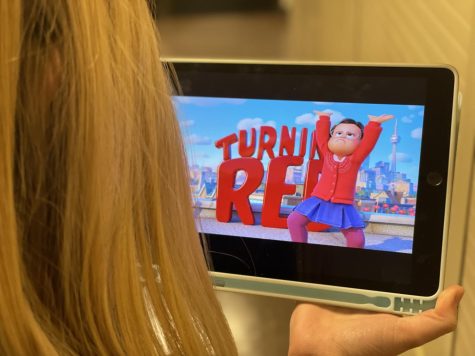Turning heads with “Turning Red”
New Disney release raises questions on cultural pressure, puberty, diversity
April 8, 2022

With a bear-like body, red fur and a skillful mind, red pandas in many ancient tales are known as a powerful force that protects the families of those to whom they are connected. Similarly, in the Disney movie “Turning Red,” which premiered on Feb 21 on Disney+, the red panda represents a force of power and protection to those who harness it.
Meilin Lee, aka Mei (Rosalie Chiang), a 13-year-old girl, is seen in the film going through a tough battle to accept the power of the red panda. “Turning Red” is a heartfelt story about how a female preteen goes through puberty and must learn to keep her inner thoughts and bodily changes to herself—and becomes an enormous red panda when she fails to keep her emotions in check.
Many topics can be hard to address in a serious but also inviting way for many reasons, such as sensitivity towards the audience or the negative attention on these certain topics might bring. Such taboo topics consist of period and puberty-related references in children’s movies.
The movie has subtle implications for puberty, but it does openly address the topic of periods. “Turning Red” stirred up many conversations regarding the symbolism of Mei becoming a red panda at the same age as one may get their period. Due to this being a Disney movie, many viewers had contrasting opinions about period products like pads being included in the film.
While some thought periods should not be so blatantly discussed in a children’s movie, others saw great potential in the inclusion of issues that teenagers go through.
Several past Disney movies helped preteens and teens understand the changes they are going through by using metaphors and symbolism, and many see “Turning Red” as another film that employs that strategy.
Along with symbolism representing periods and puberty, this film has a wide array of diverse characters of different races and backgrounds.
Mei’s friend group consisted of her three best friends; Miriam Mendelsohn (Ava Morse) a tomboy, Priya Mangal (Maitreyi Ramakrishnan) an Indian-Canadian and Abby Park (Hyein Park), who is a Korean-Canadian. The film is centered around these four girls. Most audience members will be able to relate in some way to one of these main characters, whether that be because of their racial identity, their awkwardness or their obsession with a famous boy band.
With the protagonist’s friend group coming from very diverse families, there are also appearances of side characters wearing hijabs, turbans and even a classmate of Mei’s that has a diabetic patch. Therefore, the film is not only diverse in the sense of race, but also in terms of physical and medical diversity.
By including many diverse individuals included in the movie in natural and realistic ways, “Turning Red” signifies the change that the animation industry is embarking on—especially geared toward a younger audience.
While being an animated movie by Disney targeted to a specific age demographic, many adults may find themselves identifying with the generational trauma and cultural expectations brought to attention by Mei’s family dynamic.
Mei is an only child with an overbearing mother. Still, the circumstances given by the film show that this is an issue suffered throughout all generations, even by Mei’s mother herself. The emotion within these relationships allows the audience to feel sympathy for a character they didn’t agree with for the majority of the film, which speaks to the story’s power.
Correctly addressing cultural expectations can be difficult, especially in a children’s movie. “Turning Red” does a wonderful job at presenting a topic as strong as familial issues; it does so in a way that will allow those of an older, more experienced generation to learn from the message of the film.
The main cultural expectation of honoring family and following the rules and instructions of elders were themes of note throughout the film. Mei struggles with finding her true self, especially if it doesn’t align with what her parents expect of her.
But throughout all of Mei’s struggles, her friends—her biggest support system—did not leave her side. Many serious topics are addressed in the film, but it includes many heartwarming moments of friendship and the love a family has for each other.
Many see the red panda as a representation of different symbols. Some see it as a metaphor for puberty. Others view it as the dreams that we fight for against cultural expectations. At the same time, some can also say it is just a children’s movie about a red panda.
However, it can be clearly said that there has been a new standard set by “Turning Red”, and many viewers are eager to see what other important topics future Disney films will address.

























































































